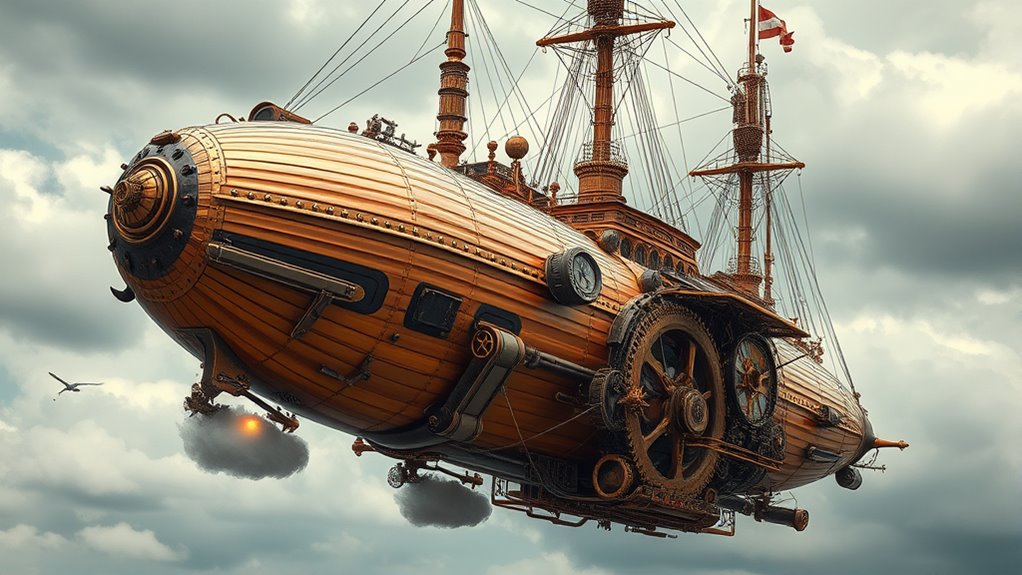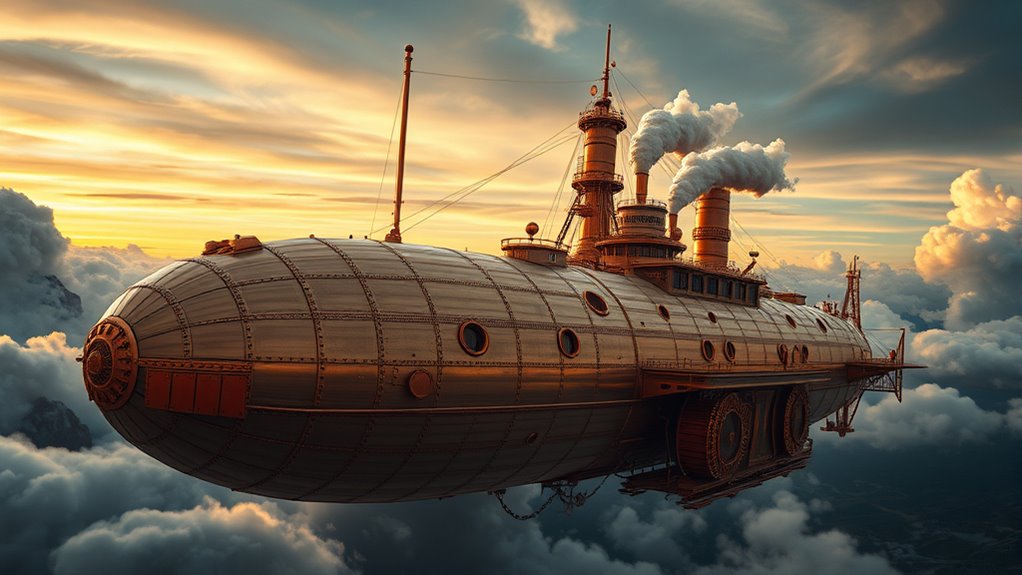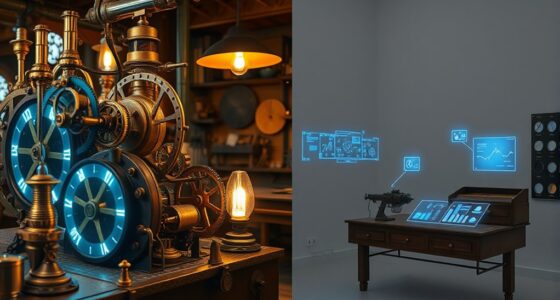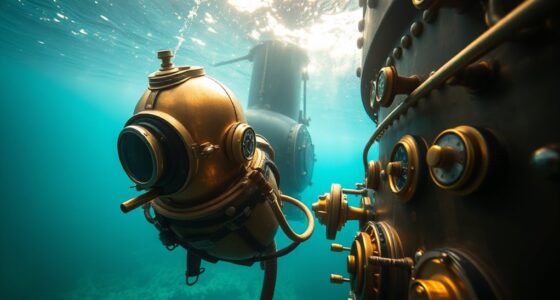Steampunk airships operate using Victorian-inspired engines fueled by coal or other combustibles that generate thrust through attached propellers or paddle wheels. The hulls, made from polished wood, brass, and steel, are riveted for strength and aesthetic appeal. Mechanical components like levers, gauges, and valves control navigation and stability, mimicking intricate Victorian machinery. Rivets secure the balloon fabric, which is crafted from heavy canvas or silk. If you continue exploring, you’ll uncover the fascinating mechanics behind these iconic flying vessels.
Key Takeaways
- Gas-powered engines fueled by coal or combustible materials provide thrust for lift and movement.
- Engines are connected to belts and gears that drive propellers or paddle wheels for propulsion.
- Rivets secure balloon fabric to the structural frame, maintaining shape and adding decorative Victorian detail.
- The hull is constructed from polished wood, brass, and steel, emphasizing durability and Victorian aesthetic.
- Mechanical controls like levers, valves, and gauges enable precise navigation and operation of propulsion and steering systems.

Have you ever wondered what it would be like to soar through the skies in a vessel that blends Victorian elegance with industrial innovation? Steampunk airships make that dream a reality, combining intricate craftsmanship with powerful technology. At the heart of these majestic vessels are gas-powered engines, which provide the thrust needed to lift and propel them through the air. Unlike modern airplanes that rely on jet engines, steampunk airships often use large, robust gas engines fueled by coal or other combustible materials. These engines are designed to produce steady, reliable power, allowing the airship to stay aloft for extended periods. You’ll notice the engine compartments are often adorned with decorative rivets, adding a touch of Victorian artistry to the otherwise industrial machinery. These rivets aren’t just functional—they’re a deliberate aesthetic choice, emphasizing the craftsmanship and attention to detail typical of steampunk design. As you observe the airship’s structure, you’ll see that the hull is crafted from polished wood, brass, and steel, all reinforced with hundreds of rivets that give the vessel a rugged yet refined appearance. These rivets serve a practical purpose, holding together the various panels and reinforcements, but they also contribute to the vessel’s vintage charm. The gas-powered engines are connected to a series of belts and gears, which transfer power to the propellers or paddle wheels that push the airship forward. The controls are often a complex network of levers, valves, and gauges, each part meticulously designed to look like a piece of Victorian machinery. You might also notice the use of decorative rivets along the edges of the balloon fabric, which is typically made from heavy canvas or silk coated with protective materials. These rivets secure the fabric to the structural frame, ensuring the balloon maintains its shape and integrity under various atmospheric conditions. The propulsion and steering mechanisms are often a marvel of mechanical ingenuity, allowing the pilot to navigate with precision. All these components—gas engines, riveted hulls, and detailed fittings—combine to create a vessel that not only functions efficiently but also exudes a unique aesthetic charm. Steampunk airships are more than just flying machines; they’re moving works of art that reflect a bygone era’s fascination with innovation and elegance. When you step aboard one, you’re stepping into a world where Victorian grandeur meets steam-powered engineering, making every flight an extraordinary journey through imagination and craftsmanship.
Frequently Asked Questions
What Materials Are Used to Build Steampunk Airship Hulls?
You use materials like polished brass, copper, and riveted steel for steampunk airship hulls, reflecting their historical context and aesthetic influences. These materials give the hulls a vintage, industrial look reminiscent of 19th-century engineering. You might also incorporate leather accents and wood panels to enhance the Victorian-inspired style. This combination creates a nostalgic yet functional design, blending historical craftsmanship with imaginative steampunk fantasy.
How Do Steampunk Airships Navigate Without Modern GPS?
You navigate your steampunk airship using magnetic compasses that point true north, guiding your way through swirling clouds and shifting winds. Celestial guidance comes into play at night, where you read the stars and constellations, aligning your course with known celestial patterns. These time-tested methods allow you to chart a steady course across the sky, blending Victorian ingenuity with the natural wonders overhead, ensuring you reach your destination safely.
What Fuel Sources Power Steampunk Airship Engines?
You’ll find that steampunk airship engines mainly run on steam engines powered by coal fuel. You load coal into the boiler, where it burns to produce heat, turning water into steam. This steam then drives pistons or turbines, propelling the airship forward. The combination of the steam engine and coal fuel creates a reliable, powerful source of energy, perfect for steering the skies in your vintage-inspired steampunk world.
How Are Safety Measures Incorporated Into Steampunk Airship Designs?
You’ll find safety measures built into steampunk airship designs, because safety first is the name of the game. You manage ballast carefully to maintain stability, and fire safety protocols are strict to prevent disasters. From reinforced cabins to emergency parachutes, these ships are designed with a watchful eye on safety. It’s a balancing act, but with these precautions, you’re better equipped to keep your voyage secure and sound.
Can Steampunk Airships Operate in Various Weather Conditions?
You’ll find that steampunk airships often have good weather resilience, enabling them to handle various conditions. Their atmospheric adaptability comes from sturdy materials and clever design features like reinforced hulls and adjustable sails. While they’re not invincible to extreme weather, skilled pilots and updated safety measures help them navigate through light storms or changing winds. Ultimately, their design balances aesthetic charm with practical resilience against diverse atmospheric challenges.
Conclusion
So, even though steampunk airships look like they’ve stepped out of a Victorian fantasy, they’re powered by surprisingly familiar technology—steam engines and gears. Think of it as blending old-world charm with modern curiosity. Just like your favorite vintage watch, they combine intricate craftsmanship with innovative ideas. As you imagine soaring through the skies in these fantastical vessels, remember: sometimes, the most extraordinary journeys start with a simple twist of a gear.








